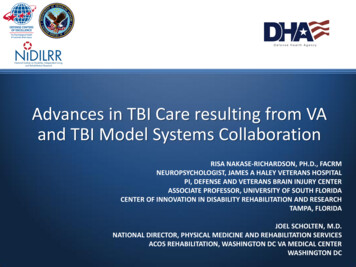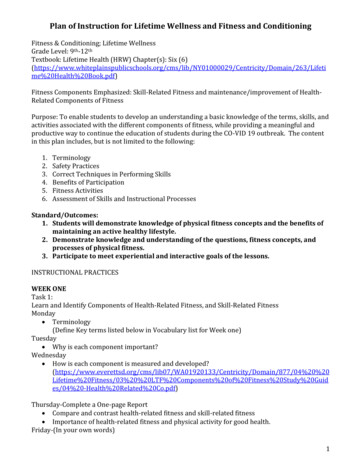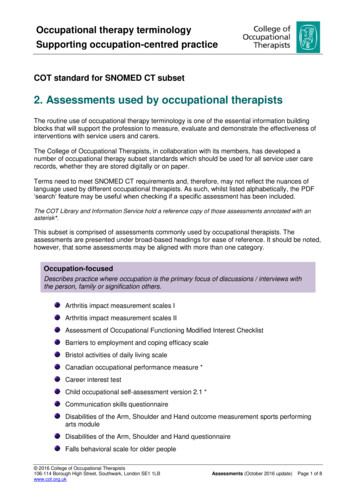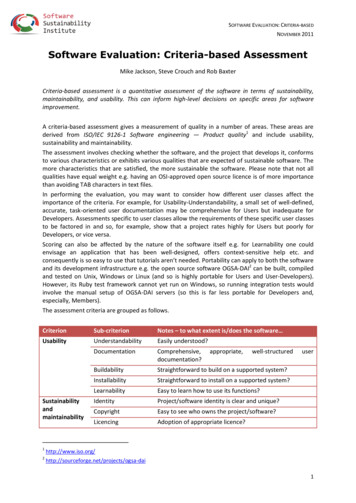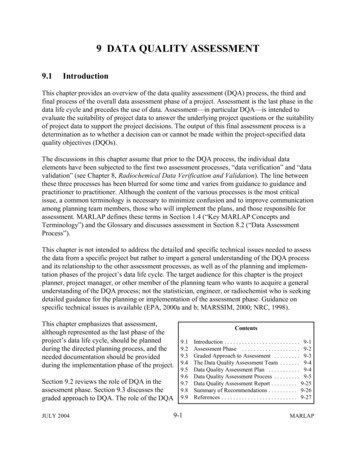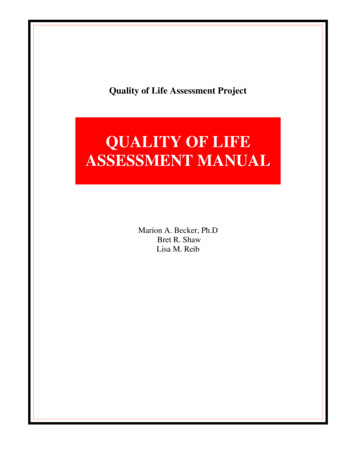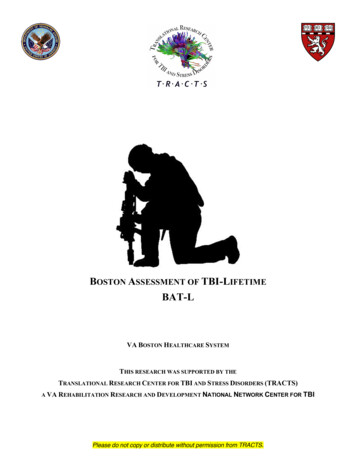
Transcription
BOSTON ASSESSMENT OF TBI-LIFETIMEBAT-LVA BOSTON HEALTHCARE SYSTEMTHIS RESEARCH WAS SUPPORTED BY THETRANSLATIONAL RESEARCH CENTER FOR TBI AND STRESS DISORDERS (TRACTS)A VA REHABILITATION RESEARCH AND DEVELOPMENT NATIONAL NETWORK CENTER FOR TBIPlease do not copy or distribute without permission from TRACTS.
BOSTON ASSESSMENT OF TBI-LIFETIMEBAT-LThe Boston Assessment of Traumatic Brain Injury-Lifetime (BAT-L) was designed to capture the unique injuries sustainedduring post-9/11 deployment with particular attention to blast injuries. In addition, head injuries incurred across thelifespan are evaluated. The emphasis of this semi-structured interview is to obtain a detailed account of the injuryincluding the context and events occurring before, during, and after the injury in both civilian and military experiences.AdministrationThe BAT-L was created for use in a research setting where detailed information regarding TBI incidence and severity isnecessary. The instrument guides the examiner in gathering necessary information from veterans and service membersabout the three worst TBIs for each category of injury (military blast, military other, pre-military, and post-military).Information is reviewed by a TBI diagnostic consensus team consisting of at least three doctoral-level psychologists,including at least one neuropsychologist. The consensus approach is integral to the instrument. If used without aconsensus team, review of selected cases is suggested to assure a consistent diagnostic approach. It may be used bothindependently as well as part of a larger clinical interview. Please contact the TRACTS team for consultation and trainingrequests.BAT-L Table of ContentsPageSummary Score Tables3Military InjuriesBlast-relatedBlast final queryMilitary-Other616Civilian InjuriesPre-Military25Post-MilitaryBlunt final query3240BAT-L hybrid classification system for the diagnosis of mTBI into mild Grade I, II, and III injuries (adapted fromBailes and Cantu, 2001) and VA and DoD consensus criteria for TBI severity as defined in the Clinical practiceguidelines: management of concussion—mild traumatic brain injury (mTBI). (DOD, 2009).CriteriaLoss ofConsciousnessGrade IMildGrade IIGrade III 5 minutesand 30minutesModerateSevere 30 minutesand 24 hours 24 hoursNone 5 minutesAlteration of MentalStatus0 – 15minutes 15minutes and 24 hours 24 hours 24 hours; severity based onother criteriaPost TraumaticAmnesia0 – 15minutes 15minutes and 24 hours 24 hours 1 day and 7 days 7 days9 - 12 9Glascow Coma Scale13 - 15Department of Veterans Affairs and Department of Defense. (2009). VA/DOD clinical practice guideline for the management ofconcussion/mild traumatic brain injury. Retrieved from http://www.healthquality.va.gov/mtbi/concussion mtbi full 1 0.pdf.Ver. 9/12/2019BAT-L 2SUMMARY SECTION
BOSTON ASSESSMENT OF TBI-LIFETIMEBAT-L SUMMARY SCORE SHEETMILITARY BLAST:Total # of Blast Exposures:0 - 10 Meters11 - 25 Meters26 - 100 MetersTotal # Blast TBIs:1st Most SevereAge2nd Most Severe3rd Most SevereAgeAgeAMShr / min / secAMShr / min / secAMShr / min / secPTAhr / min / secPTAhr / min / secPTAhr / min / secLOChr / min / secLOChr / min / secLOChr / min / secSeverityq Mildq Moderateq SevereIf Mild:q Stage Iq Stage IIq Stage IIISeverityq Mildq Moderateq SevereIf Mild:q Stage Iq Stage IIq Stage IIISeverityq Mildq Moderateq SevereBATL Score(0 – 5)BATL Score(0 – 5)BATL Score(0 – 5)Nature of BlastNature of BlastNature of BlastIf Mild:q Stage Iq Stage IIq Stage IIIq Primary(Head)q Primary(Head)q Primary(Head)q Secondary(Head: q Yes q No)q Secondary(Head: q Yes q No)q Secondary(Head: q Yes q No)q Tertiary(Head: q Yes q No)q Tertiary(Head: q Yes q No)q Tertiary(Head: q Yes q No)q Quaternary(Head: q Yes q No)q Quaternary(Head: q Yes q No)q Quaternary(Head: q Yes q No)Ver. 9/12/2019BAT-L 3SUMMARY SECTION
BOSTON ASSESSMENT OF TBI-LIFETIMEMILITARY OTHER:Total # Other TBIs:1st Most SevereAge2nd Most Severe3rd Most SevereAgeAgeAMShr / min / secAMShr / min / secAMShr / min / secPTAhr / min / secPTAhr / min / secPTAhr / min / secLOChr / min / secLOChr / min / secLOChr / min / secSeverityq Mildq Moderateq SevereIf Mild:q Stage Iq Stage IIq Stage IIISeverityq Mildq Moderateq SevereIf Mild:q Stage Iq Stage IIq Stage IIISeverityq Mildq Moderateq SevereIf Mild:q Stage Iq Stage IIq Stage IIIBATL Score(0 – 5)BATL Score(0 – 5)BATL Score(0 – 5)Nature of InjuryNature of InjuryNature of Injuryq MVAq Physical Assaultq MVAq Physical Assaultq MVAq Physical Assaultq Fallq Penetrating Injuryq Fallq Penetrating Injuryq Fallq Penetrating Injuryq SportsRelatedq Other:q SportsRelatedq Other:q SportsRelatedq Other:PRE-MILITARY:Total # TBIs:1st Most SevereAge2nd Most Severe3rd Most SevereAgeAgeAMShr / min / secAMShr / min / secAMShr / min / secPTAhr / min / secPTAhr / min / secPTAhr / min / secLOChr / min / secLOChr / min / secLOChr / min / secSeverityq Mildq Moderateq SevereIf Mild:q Stage Iq Stage IIq Stage IIISeverityq Mildq Moderateq SevereIf Mild:q Stage Iq Stage IIq Stage IIISeverityq Mildq Moderateq SevereIf Mild:q Stage Iq Stage IIq Stage IIIBATL Score(0 – 5)BATL Score(0 – 5)BATL Score(0 – 5)Nature of InjuryNature of InjuryNature of Injuryq MVAq Physical Assaultq MVAq Physical Assaultq MVAq Physical Assaultq Fallq Penetrating Injuryq Fallq Penetrating Injuryq Fallq Penetrating Injuryq Sportsq Other:q Sportsq Other:q Sportsq Other:Ver. 9/12/2019BAT-L 4SUMMARY SECTION
BOSTON ASSESSMENT OF TBI-LIFETIMEPOST-MILITARY:Total # TBIs:1st Most SevereAge2nd Most Severe3rd Most SevereAgeAgeAMShr / min / secAMShr / min / secAMShr / min / secPTAhr / min / secPTAhr / min / secPTAhr / min / secLOChr / min / secLOChr / min / secLOChr / min / secSeverityq Mildq Moderateq SevereIf Mild:q Stage Iq Stage IIq Stage IIISeverityq Mildq Moderateq SevereIf Mild:q Stage Iq Stage IIq Stage IIISeverityq Mildq Moderateq SevereIf Mild:q Stage Iq Stage IIq Stage IIIBATL Score(0 – 5)BATL Score(0 – 5)BATL Score(0 – 5)Nature of InjuryNature of InjuryNature of Injuryq MVAq Physical Assaultq MVAq Physical Assaultq MVAq Physical Assaultq Fallq Penetrating Injuryq Fallq Penetrating Injuryq Fallq Penetrating Injuryq SportsRelatedq Other:q SportsRelatedq Other:q SportsRelatedq Other:BAT-L Score (0 – 5):BAT-L Lifetime Total Score0 no TBI1 mTBI grade I2 mTBI grade II3 mTBI grade III4 moderate TBI5 severe TBISum Military Blast BATL ScoresSum Military Other BATL ScoresSum Pre-Military BATL ScoresSum Post-Military BATL ScoresBAT-L TOTAL LIFETIME SCORE TOTALBAT-L Total Score Sum of the scores for the three worst TBIs across all categories of injury (blast-related, militaryother, pre-military, and post-military) (BAT-L Total Score: Range 0 - 60).Total Estimated Repetitive Blasts/Exposures:Total Estimated Repetitive Blunt Exposures:Ver. 9/12/2019BAT-L 5SUMMARY SECTION
BOSTON ASSESSMENT OF TBI-LIFETIMEMILITARY HEAD INJURIESDuring this interview I will be asking you about any blows to the head that may have occurred to you during your life. First,I will ask you about any blasts or explosions you may have been exposed to while in the military.MILITARY BLAST:During your time in the military, were you involved in any blasts or explosions within 100 meters?q Uncertainq NoIf no, query further about types of blasts/explosions (item 1 below) to rule out blastexposure then discontinue questionnaire if none.q YesIf yes, How many blasts were you exposed to within meters? 10 meters:Cue: Approximately 32 feet or the length of 2 parking spaces11 – 25 meters:Cue: Approximately 82 feet or the distance between home base and first base in aprofessional baseball diamond26 – 100 meters:Cue: Approximately 320 feet or the length of a professional football fieldTotal Blasts:Next, I am going to ask you about the three worst or most severe blasts you experienced while deployed. I am notlooking for the most upsetting incidents, but rather the blasts that were the most severe or that were thestrongest/closest.MILITARY BLAST #1 (Most Severe):Age (or best estimate) at time of occurrence:1. What type of blast/accident was it?q Unknownq Grenadeq Bombq IEDq Land mineq Rocketq RPGq Mortarq Suicide vest/bombq Other:2. Do you remember the blast/accident itself? If yes, Can you describe it to me? If you don’t remember, can you tellme what other people said happened?a. Were others seriously injured?q Uncertainq Noq Yesb. How far away was the blast/explosion? Clarify/confirm distance of closest blast/explosion for consistency. Ifpatient is uncertain, encourage pt to provide an estimate.Ver. 9/12/2019BAT-L 6MILITARY BLAST #1
BOSTON ASSESSMENT OF TBI-LIFETIMEc. What is the last thing you can remember just before the blast/accident? Clarify timing of events. Cue pt to walkyou through time until it is clear there are no gaps in memory. Probe to ensure clear recall.d. What is the first thing you can remember just after the blast/accident? Following pt’s response ask, How long doyou think that was after the blast? Clarify timing of events. Cue pt to walk you through time until it is clear thereare no gaps in memory. Probe to ensure clear recall.e. If injury is the result of an IED or bomb ask, Do you remember hearing the explosion?q Uncertainq Noq Yesf. Do you remember feeling the pressure changes associated with the blast?q Uncertainq Noq Yesg. What direction did the blast wave/blast come from? (multiple boxes may be checked)q Uncertainq Frontq Backq Leftq Rightq Underq AboveWas it an incoming blast?q Uncertainq Noq YesIf no, What type/direction:h. Were you thrown by the blast/accident, either out of a vehicle or off of your feet? Did you hit your head? Wassomething propelled or thrown at you/your head by the blast/accident? If yes, ask pt to provide as muchinformation and detail as possible. Note type of vehicle and position in the vehicle if pt was in a vehicle at thetime of the blast.i. Did you experience any changes in your vision or hearing during the accident? Establish that the pt is notreporting mental status change when was in fact hearing/vision change.q Uncertainq Noq YesAny bleeding from your eardrum?q Uncertainq Noq Yesj. Did you experience confusion or disorientation (not sure where you were, what day or time it was, performsimple math calculations/multistep commands/multistep commands, perform duties as expected) after theblast/accident? If so, for how long? With this and the following question, try to determine if the pt experiencedan actual change in mental status vs. vision/hearing difficulty associated with the blast/accident vs. the chaossurrounding the event. Probe if others thought pt was functioning normally.Ver. 9/12/2019BAT-L 7MILITARY BLAST #1
BOSTON ASSESSMENT OF TBI-LIFETIMEk. Did you experience a loss of consciousness at the time of the blast/accident (were you ‘knocked out’)? If so, forhow long? If yes, was LOC witnessed (were you told by others you were knocked out/unconscious)? Probe toensure LOC is not due to anoxia/alcohol/substance overdose. Probe to differentiate LOC from PTA (if possible).q Uncertainq Noq Yesl. Did you experience any of the following immediately after the event? Note general Sx duration.q HeadachesDuration:q Trouble thinkingDuration:q NauseaDuration:q DizzinessDuration:q FatigueDuration:q Poor coordination, balance problems, or slowed reaction timesDuration:q Sensory changes (Hearing/Vision/Taste/Smell)Duration:q Numbness or tinglingDuration:q Mood changes (Anxiety/Depression/Irritability)Duration:q Sleep troubleDuration:q Other:Duration:3. At the time of the blast/accident, were you wearing a helmet, and if so was it modified (equipped with upgrade kit)?q Uncertainq Noq YesIf yes, was it modified?q Uncertainq Noq YesIf yes, did the helmet stay on your head?q Uncertainq Noq Yes4. At the time of blast/accident, were you wearing Kevlar body armor?q Uncertainq Noq Yes5. After the injury did you see a physician, trainer, medic or other trained personnel?q Uncertainq Noq YesIf yes, MACE (field mental status eval)?q Uncertainq Noq YesIf yes, was anything documented in your medical record?q Uncertainq Noq YesIf yes, do you have access to those records?q Uncertainq Noq YesVer. 9/12/2019BAT-L 8MILITARY BLAST #1
BOSTON ASSESSMENT OF TBI-LIFETIME6. Did you experience a disruption of duty after the blast/accident?q Uncertainq Noq YesIf Yes:For how long were you pulled from duty?Did you return to active duty?Did this event lead to medical hold?Sick leave?Discharge?EVALUATE MILITARY BLAST #1:Using the questions above, or in spontaneous dialogue, evaluate the following:Alteration ofmental status:q NOq YESIf yes, enter the estimated duration of the AMS?hr / min / sec*AMS AMS PTA LOCPTA:q NOq YESIf yes, enter the estimated duration of the PTA?hr / min / sec*PTA PTA LOCLOC:q NOq YESIf yes, enter the estimated duration of the LOC?hr / min / secDoes the patient actually recall this information themselves? (e.g., can providespecific information regarding what they were doing when blast occurred, etc., orwas knowledge gained from the reports of witnesses?)q Uncertainq NoSubstance Related:q NOq YESq YesSetting of Injury:q Combatq Non-CombatMilitary (e.g.,training)Emotional Context ofInjury:q Traumaticq Non-traumaticBlast Injuries:q Primary: Injury from over-pressurization force (blast wave) impacting the body surface — TM rupture, pulmonarydamage and air embolization, hollow viscus injuryq Secondary: Injury from projectiles (bomb fragments, flying debris) — Penetrating trauma, fragmentation injuries,blunt traumaq Tertiary: Injuries from displacement of victim by the blast wind — Blunt/penetrating trauma, fractures, andtraumatic amputationsq Quaternary: All other injuries from the blast — Crush injuries, burns, asphyxia, toxic exposures, exacerbations ofchronic illnessVer. 9/12/2019BAT-L 9MILITARY BLAST #1
BOSTON ASSESSMENT OF TBI-LIFETIMEMILITARY BLAST #2 (Second Most Severe):Age (or best estimate) at time of occurrence:1. What type of blast/accident was it?q Unknownq Grenadeq Bombq Other:q IEDq Land mineq Rocketq RPGq Mortarq Suicide vest/bomb2. Do you remember the blast/accident itself? If yes, Can you describe it to me? If you don’t remember, can you tellme what other people said happened?a. Were others seriously injured?q Uncertainq Noq Yesb. How far away was the blast/explosion? Clarify/confirm distance of closest blast/explosion for consistency. Ifpatient is uncertain, encourage pt to provide an estimate.c. What is the last thing you can remember just before the blast/accident? Clarify timing of events. Cue pt to walkyou through time until it is clear there are no gaps in memory. Probe to ensure clear recall.d. What is the first thing you can remember just after the blast/accident? Following pt’s response ask, How long doyou think that was after the blast? Clarify timing of events. Cue pt to walk you through time until it is clear thereare no gaps in memory. Probe to ensure clear recall.e. If injury is the result of an IED or bomb ask, Do you remember hearing the explosion?q Uncertainq Noq Yesf. Do you remember feeling the pressure changes associated with the blast?q Uncertainq Noq Yesg. What direction did the blast wave/blast come from? (multiple boxes may be checked)q Uncertainq Frontq Backq Leftq Rightq Underq AboveWas it an incoming blast?q Uncertainq Noq YesIf no, What type/direction:Ver. 9/12/2019BAT-L 10MILITARY BLAST #3
BOSTON ASSESSMENT OF TBI-LIFETIMEh. Were you thrown by the blast/accident, either out of a vehicle or off of your feet? Did you hit your head? Wassomething propelled or thrown at you/your head by the blast/accident? If yes, ask pt to provide as muchinformation and detail as possible. Note type of vehicle and position in the vehicle if pt was in a vehicle at thetime of the blast.i. Did you experience any changes in your vision or hearing during the accident? Establish that the pt is notreporting mental status change when was in fact hearing/vision change.q Uncertainq Noq YesAny bleeding from your eardrum?q Uncertainq Noq Yesj. Did you experience confusion or disorientation (not sure where you were, what day or time it was, performsimple math calculations/multistep commands, perform duties as expected) after the blast/accident? If so, forhow long? With this and the following question, try to determine if the pt experienced an actual change inmental status vs. vision/hearing difficulty associated with the blast/accident vs. the chaos surrounding the event.Probe if others thought pt was functioning normally.k. Did you experience a loss of consciousness at the time of the blast/accident (were you ‘knocked out’)? If so, forhow long? If yes, was LOC witnessed (were you told by others you were knocked out/unconscious)? Probe toensure LOC is not due to anoxia/alcohol/substance overdose. Probe to differentiate LOC from PTA (if possible).q Uncertainq Noq Yesl. Did you experience any of the following immediately after the event? Note general Sx duration.q HeadachesDuration:q Trouble thinkingDuration:q NauseaDuration:q DizzinessDuration:q FatigueDuration:q Poor coordination, balance problems, or slowed reaction timesDuration:q Sensory changes (Hearing/Vision/Taste/Smell)Duration:q Numbness or tinglingDuration:q Mood changes (Anxiety/Depression/Irritability)Duration:q Sleep troubleDuration:q Other:Duration:3. At the time of the blast/accident, were you wearing a helmet, and if so was it modified (equipped with upgrade kit)?q Uncertainq Noq YesIf yes, was it modified?q Uncertainq Noq YesIf yes, did the helmet stay on your head?q Uncertainq Noq YesVer. 9/12/2019BAT-L 11MILITARY BLAST #3
BOSTON ASSESSMENT OF TBI-LIFETIME4. At the time of blast/accident, were you wearing Kevlar body armor?q Uncertainq Noq Yes5. After the injury did you see a physician, trainer, medic or other trained personnel?q Uncertainq Noq YesIf yes, MACE (field mental status eval)?q Uncertainq Noq YesIf yes, was anything documented in your medical record?q Uncertainq Noq YesIf yes, do you have access to those records?q Uncertainq Noq Yes6. Did you experience a disruption of duty after the blast/accident?q Uncertainq Noq YesIf Yes:For how long were you pulled from duty?Did you return to active duty?Did this event lead to medical hold?Sick leave?Discharge?EVALUATE MILITARY BLAST #2:Using the questions above, or in spontaneous dialogue, evaluate the following:Alteration ofmental status:q NOq YESIf yes, enter the estimated duration of the AMS?hr / min / sec*AMS AMS PTA LOCPTA:q NOq YESIf yes, enter the estimated duration of the PTA?hr / min / sec*PTA PTA LOCLOC:q NOq YESIf yes, enter the estimated duration of the LOC?hr / min / secDoes the patient actually recall this information themselves? (e.g., can providespecific information regarding what they were doing when blast occurred, etc., orwas knowledge gained from the reports of witnesses?)q Uncertainq NoSubstance Related:q NOq YESq YesSetting of Injury:q Combatq Non-CombatMilitary (e.g.,training)Emotional Context ofInjury:q Traumaticq Non-traumaticBlast Injuries:q Primary: Injury from over-pressurization force (blast wave) impacting the body surface — TM rupture, pulmonarydamage and air embolization, hollow viscus injuryq Secondary: Injury from projectiles (bomb fragments, flying debris) — Penetrating trauma, fragmentation injuries,blunt traumaq Tertiary: Injuries from displacement of victim by the blast wind — Blunt/penetrating trauma, fractures, andtraumatic amputationsq Quaternary: All other injuries from the blast — Crush injuries, burns, asphyxia, toxic exposures, exacerbations ofchronic illnessVer. 9/12/2019BAT-L 12MILITARY BLAST #3
BOSTON ASSESSMENT OF TBI-LIFETIMEMILITARY BLAST #3 (Third Most Severe):1. What type of blast/accident was it?q Unknownq Grenadeq Bombq Other:q IEDq Land mineq Rocketq RPGq Mortarq Suicide vest/bomb2. Do you remember the blast/accident itself? If yes, Can you describe it to me? If you don’t remember, can you tellme what other people said happened?a. Were others seriously injured?q Uncertainq Noq Yesb. How far away was the blast/explosion? Clarify/confirm distance of closest blast/explosion for consistency. Ifpatient is uncertain, encourage pt to provide an estimate.c. What is the last thing you can remember just before the blast/accident? Clarify timing of events. Cue pt to walkyou through time until it is clear there are no gaps in memory. Probe to ensure clear recall.d. What is the first thing you can remember just after the blast/accident? Following pt’s response ask, How long doyou think that was after the blast? Clarify timing of events. Cue pt to walk you through time until it is clear thereare no gaps in memory. Probe to ensure clear recall.e. If injury is the result of an IED or bomb ask, Do you remember hearing the explosion?q Uncertainq Noq Yesf. Do you remember feeling the pressure changes associated with the blast?q Uncertainq Noq Yesg. What direction did the blast wave/blast come from? (multiple boxes may be checked)q Uncertainq Frontq Backq Leftq Rightq Underq AboveWas it an incoming blast?q Uncertainq Noq YesIf no, What type/direction:Ver. 9/12/2019BAT-L 13MILITARY BLAST #3
BOSTON ASSESSMENT OF TBI-LIFETIMEh. Were you thrown by the blast/accident, either out of a vehicle or off of your feet? Did you hit your head? Wassomething propelled or thrown at you/your head by the blast/accident? If yes, ask pt to provide as muchinformation and detail as possible. Note type of vehicle and position in the vehicle if pt was in a vehicle at thetime of the blast.i. Did you experience any changes in your vision or hearing during the accident? Establish that the pt is notreporting mental status change when was in fact hearing/vision change.q Uncertainq Noq YesAny bleeding from your eardrum?q Uncertainq Noq Yesj. Did you experience confusion or disorientation (not sure where you were, what day or time it was, performsimple math calculations/multistep commands, perform duties as expected) after the blast/accident? If so, forhow long? With this and the following question, try to determine if the pt experienced an actual change inmental status vs. vision/hearing difficulty associated with the blast/accident vs. the chaos surrounding the event.Probe if others thought pt was functioning normally.k. Did you experience a loss of consciousness at the time of the blast/accident (were you ‘knocked out’)? If so, forhow long? If yes, was LOC witnessed (were you told by others you were knocked out/unconscious)? Probe toensure LOC is not due to anoxia/alcohol/substance overdose. Probe to differentiate LOC from PTA (if possible).q Uncertainq Noq Yesl. Did you experience any of the following immediately after the event? Note general Sx duration.q HeadachesDuration:q Trouble thinkingDuration:q NauseaDuration:q DizzinessDuration:q FatigueDuration:q Poor coordination, balance problems, or slowed reaction timesDuration:q Sensory changes (Hearing/Vision/Taste/Smell)Duration:q Numbness or tinglingDuration:q Mood changes (Anxiety/Depression/Irritability)Duration:q Sleep troubleDuration:q Other:Duration:3. At the time of the blast/accident, were you wearing a helmet, and if so was it modified (equipped with upgrade kit)?q Uncertainq Noq YesIf yes, was it modified?q Uncertainq Noq YesIf yes, did the helmet stay on your head?q Uncertainq Noq YesVer. 9/12/2019BAT-L 14MILITARY BLAST #3
BOSTON ASSESSMENT OF TBI-LIFETIME4. At the time of blast/accident, were you wearing Kevlar body armor?q Uncertainq Noq Yes5. After the injury did you see a physician, trainer, medic or other trained personnel?q Uncertainq Noq YesIf yes, MACE (field mental status eval)?q Uncertainq Noq YesIf yes, was anything documented in your medical record?q Uncertainq Noq YesIf yes, do you have access to those records?q Uncertainq Noq Yes6. Did you experience a disruption of duty after the blast/accident?q Uncertainq Noq YesIf Yes:For how long were you pulled from duty?Did you return to active duty?Did this event lead to medical hold?Sick leave?Discharge?EVALUATE MILITARY BLAST #3:Using the questions above, or in spontaneous dialogue, evaluate the following:Alteration ofmental status:q NOq YESIf yes, enter the estimated duration of the AMS?hr / min / sec*AMS AMS PTA LOCPTA:q NOq YESIf yes, enter the estimated duration of the PTA?hr / min / sec*PTA PTA LOCLOC:q NOq YESIf yes, enter the estimated duration of the LOC?hr / min / secDoes the patient actually recall this information themselves? (e.g., can providespecific information regarding what they were doing when blast occurred, etc., orwas knowledge gained from the reports of witnesses?)q Uncertainq NoSubstance Related:q NOq YESq YesSetting of Injury:q Combatq Non-CombatMilitary (e.g.,training)Emotional Context ofInjury:q Traumaticq Non-traumaticBlast Injuries:q Primary: Injury from over-pressurization force (blast wave) impacting the body surface — TM rupture, pulmonarydamage and air embolization, hollow viscus injuryq Secondary: Injury from projectiles (bomb fragments, flying debris) — Penetrating trauma, fragmentation injuries,blunt traumaq Tertiary: Injuries from displacement of victim by the blast wind — Blunt/penetrating trauma, fractures, andtraumatic amputationsq Quaternary: All other injuries from the blast — Crush injuries, burns, asphyxia, toxic exposures, exacerbations ofchronic illnessVer. 9/12/2019BAT-L 15MILITARY BLAST #3
BOSTON ASSESSMENT OF TBI-LIFETIMEBLAST FINAL QUERY for sub-acute blast exposure training and combat:Is there anything else related to your military duties that exposed you to a high rate of blasts, munitions, orexplosives? (Regardless of presence or absence of acute AMS/PTA/LOC)q Uncertainq NoIf no, query specific causes listed below.q YesIf yes, What was the cause of the injury? Provide ranges and circle estimated # of occurrences.Breach explosives / Breach training with flashbang/C4 or similar:01-56-1011-5051-100Setting: q Combatq Training q Open fieldq EnclosedLarge caliber automatic weapons (50 cal, M240B, M60) or similar:01-56-1011-5051-100101-500500 q Unknown101-500500 Setting: q Combatq Training q Open fieldq Enclosed q UnknownArtillery and other Large munitions (Howitzer, Abrams, etc) or similar:01-56-1011-5051-100101-500500 Setting: q Combatq Training q Open fieldq Enclosed q UnknownAnti-Tank Weapons and other shoulder fired rockets (AT4, SMAW, grenade launcher) or similar:01-5Setting: q CombatOther: Type:01-5Setting: q Combat6-10q Training6-10q TrainingWas ear or other protection worn?11-5051-100q Open fieldq Enclosed11-5051-100q Open fieldq Enclosed101-500500 q Unknown101-500500 q Unknownq Yes q No q Varied q UnknownTotal Repetitive Blasts/Exposures:*If acute TBI symptoms are reported, assess further following the format for Blast Injuries in the preceding section.MILITARY OTHER:Have you experienced other blows to the head during your time in the military? (Patient report, you willevaluate below)q Uncertainq NoIf no, query specific causes listed below, as well as further losses of consciousness or PTAthen discontinue questionnaire if none.q YesIf yes, What was the cause of the injury?q MVAq Fallq Training-related injury (e.g., obstacles, combatives, pugil stick, jumps)q Sports-related injury (e.g., football, hockey, baseball, basketball, soccer, lacrosse,boxing, wrestling, martial arts)q Physical assault/fightsq Penetrating injuryq Other: TypeVer. 9/12/2019BAT-L 16MILITARY OTHER #1
BOSTON ASSESSMENT OF TBI-LIFETIMENext, I am going to ask you about the [number 1 – 3] worst or most severe non-blast head injuries you experienced duringyour deployment.MILITARY OTHER #1 (Most Severe):Age (or best estimate) at time of occurrence:1. What type of accident was it?q MVAq Physical assaultq Fallq Penetrating injuryq Sports-related injuryq Other:2. Do you remember the event itself? If yes, Can you describe it to me? If you don’t remember, can you tell me whatother people said happened?a. Were others seriously injured?q Uncertainq Noq Yesb. What is the last thing you can remember just before the event?c. What is the first thing you can remember just after the event? Following pt’s response ask, How long do youthink that was after the event?d. Did you experience any changes in your vision or hearing after the event? Establish that the pt is not reportingmental status change when was in fact hearing/vision change.e. Did you experience confusion or disorientation (not sure where you were, what day or time it was, performsimple math calculations/multistep commands, perform duties as expected) after the event? If so, for howlong? With this and the following question, try to determine if the pt experienced an actual change in mentalstatus vs. vision/hearing difficulty associated with the blast/accident and the chaos surrounding the event.Ver. 9/12/2019BAT-L 17MILITARY OTHER #1
BOSTON ASSESSMENT OF TBI-LIFETIMEf. Did you experience a loss of consciousness at the time of the blast/accident (were you ‘knocked out’)? If so,for how long? If yes, was LOC witnessed (were you told by others you were knocked out/unconscious)? Probe toensure LOC is not due to anoxia/alcohol/substance overdose.g. Did. you experience any of the following immediately after the event? Note general Sx duration.q HeadachesDuration:q Trouble thinkingDuration:q NauseaDuration:q DizzinessDuration:q FatigueDuration:q Poor coordination, balance problems, or slowed reaction timesDuration:q Sensory changes (Hearing/Vision/Taste/Smell)Duration:q Numbness or tinglingDuration:q Mood changes (Anxiety/Depression/Irritability)Duration:q Sleep troubleDuration:q Other:Duration:3. At the time of the accident, were you wearing a helmet, and if so modified (equipped with the upgrade kit)?q Uncertainq Noq YesIf yes, Modified?q Noq Yes4. At the time of accident, were you wearing Kevlar body armor?q Uncertainq Noq Yes5. After the injury did you see a physician, trainer, medic or other trained personnel?q Uncertainq Noq Yes6. Did you experience a disruption of duty after the a
BOSTON ASSESSMENT OF TBI-LIFETIME Ver. 9/12/2019 BAT-L 2 SUMMARY SECTION BAT-L The Boston Assessment of Traumatic Brain Injury-Lifetime (BAT-L) was designed to capture the unique injuries sustained during post-9/1
